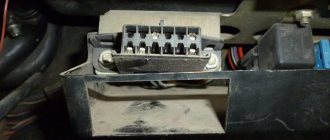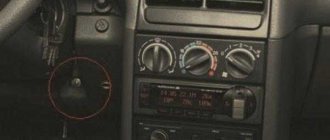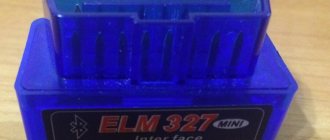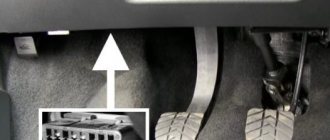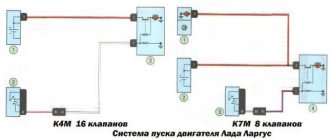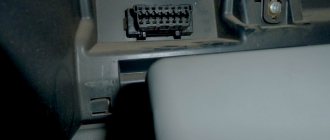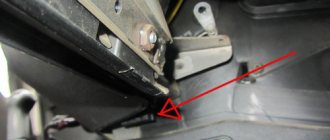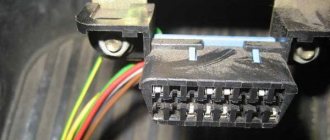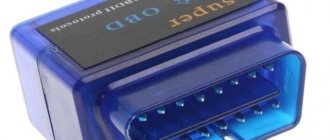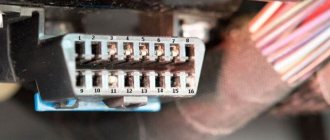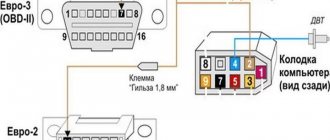Today we will talk about the pinout of the diagnostic connector.
With the advent of electronic control systems from microprocessors in cars, the need also arose to check the operating parameters of the units themselves and the connecting electrical circuits. For this purpose, equipment was invented, called OBD (On Board Diagnostic), initially it only provided information about the malfunction, without any clarification.
In modern cars, using an OBD connector with a standard pinout of the diagnostic connector, you can connect a special adapter or scanner to the on-board computer and carry out a complete diagnosis on your own for almost any motorist. Since 1996, the second concept of the OBD2 standard has been developed in the USA, which has become mandatory for newly produced cars.
Determine the purpose of OBD2:
- type of diagnostic connector;
- connector pinout for diagnostics;
- electrical communication protocols;
- message format.
The European Union has adopted EOBD, which is based on OBD2. It has been mandatory for all cars since January 2001. OBD-2 supports 5 data exchange protocols.
Knowing the location and standard pinout of the OBD2 connector, you can check the car yourself. Thanks to the widespread implementation of OBD2, when diagnosing a car, you can get an error code that will be the same regardless of the make and model of the car.
The standard code contains the X1234 structure, where each character carries its own meaning:
- X is the only letter symbol that allows you to recognize the faulty system (engine, gearbox, electronic components, etc.);
- 1 - represents the general OBD2 standard code or additional factory codes;
- 2 - clarification of the location of the malfunction (power or ignition system, auxiliary circuits, etc.);
- 34 is the serial number of the error.
The pinout of the OBD2 diagnostic connector has a special power plug from the on-board network, this allows you to use any scanners and adapters without additional electrical circuits. If earlier diagnostic protocols showed only general information about the presence of a problem, now, thanks to the connection of the diagnostic device with the electronic units of the car, more complete information about a specific malfunction can be read.
Each connected diagnostic equipment must comply with one of three international standards:
- CAN;
- SAE J1850;
- ISO 9141-2.
The location of the OBD2 diagnostic connector and pinout for diagnostics can vary greatly from vehicle to vehicle. There is no single standard for location; the car's operating instructions or sleight of hand will help you here.
Below are a few common points for easy reference:
- in the slot in the lower casing of the instrument panel in the area of the driver’s left knee;
- under the ashtray installed in the central part of the instrument panel (some Peugeot models);
- under plastic plugs on the bottom of the instrument panel or on the center console (typical for VAG products);
- on the rear wall of the instrument panel behind the glove box body (some Lada models);
- on the center console in the area of the parking brake lever (found on some cars
- in the lower part of the armrest niche (common on French cars);
- under the hood near the engine shield (typical of some Korean and Japanese cars).
Many motorists also sometimes intentionally move the OBD2 pinout connector to another not always standard place; this may be due to electrical wiring repairs or to protect the car from theft.
Diagnostics via OBD 2
The verification procedure is carried out as follows:
- Depending on the vehicle, the diagnostic process can be carried out with the ignition off or on. This point should be clarified in the service manual. Before starting, the ignition procedure in the car is turned off or on.
- The program is launched on the computer to check.
- The diagnostic equipment is connected to the connector. If this is a scanner, then the block with the wire from it needs to be inserted into the plug. When using a PC, one end of the adapter is installed in the USB output of the computer, and the other is connected to the connector.
- You need to wait until the program detects the block after synchronization. If this does not happen, you should manually go to the control menu and select the option to search for new devices.
- The diagnostic procedure starts on the computer. Depending on the software, the user may have the option to select the desired verification tool. Some programs support separate diagnostics of the engine, transmission unit, electrical network and other components.
- After completing the test procedure, fault codes will appear on the PC screen. These errors must be deciphered in order to accurately determine the type of failure. In accordance with the data received, the vehicle is repaired.
When is diagnostics required?
The first sign that the car system should be diagnosed will be the blinking of the CHECK ENGINE lamp located on the instrument panel. Please note that the presence of errors in the system will be the fact that after 10 seconds after starting the engine, the warning light will not go out and the error data will be stored in the ECU memory.
The error is indicated by an arrow.
Where is the connector?
In order to read all the fault codes that have arisen using diagnostic equipment, you will have to get to the diagnostic connector, which is located directly under the instrument panel console on the left side.
The location of the diagnostic block is indicated by an arrow.
You will detect it immediately as soon as you look at the approximate area of its location, since its characteristic shape is very specific.
Description of diagnostic connector OBD2 codes
OBD II
What is an OBD diagnostic connector?
It is very important that the presence of a similar connector does not mean 100 percent compatibility with OBD-II. Cars equipped with this system must have a mark on one of the plates in the engine compartment and/or in the accompanying documentation
The most commonly used protocol can be identified by the presence/absence of certain pins on the diagnostic connector. If all contacts are present on this connector, you should refer to the technical documentation for the specific car, which is available on the website.
OBD II diagnostic connector
Pin designation
- OEM
- J1850 Bus + Line, SAE
- OEM
- Body grounding
- Signal Ground
- Upper CAN Contact (J-2284)
- K Line ISO 9141-2
- OEM
- OEM
- Bus - Line, Sae J1850 Tire
- OEM
- OEM
- OEM
- Bottom CAN Contact (J-2284)
- L Line ISO 9141-2
- Battery voltage
Diagnostic connector pins for protocols used. Pins 4, 5, 7, 15, 16 - ISO 9141-2. Pins 2, 4, 5, 10, 16 - J1850 PWM. Pins 2, 4, 5, 16 (without 10) - J1850 VPW. ISO 9141-2 protocol is identified by the presence of pin 7 and the absence of pins 2 and/or 10 on the diagnostic connector. If pin 7 is missing, the system uses the SAE J1850 VPW (Variable Pulse Width Modulation) or SAE J1850 PWM (Pulse WidthModulation) protocol. All three data exchange protocols operate via a standard OBD-II J1962connector cable.
DTC Descriptions
The DTC consists of 5 digits. The figure below shows the structure of the DTC code. With this information, you can clear the DTC even if you do not have a description of the DTC.
List of the most common OBDII abbreviations
AFC – Air flow meter ALDL – Diagnostic connector. This is what the diagnostic connector for GM cars used to be called, as well as the connector for connecting a scanner; can also be used as the name of any OBD signal IICAN - ControllerCARB - California Atmospheric Resources BoardCFI - Central Fuel Injection (TBI)CFI - Continuous Fuel InjectionCO - Carbon MonoxideDLC - Diagnostic ConnectorDriving Cycle - The sequence of starting, warming up and driving the vehicle, during this cycle all tests are performed OBD Functions IIDTC – Malfunction CodeECM – Engine Control ModuleEEC – Electronic Engine ControlEEPROM or E2PROM – Programmable Read-Only MemoryEFI – Electronic Fuel InjectionEGR – Exhaust Gas RecirculationEMR – Electronic Ignition Reduction UnitEPA – Environmental Protection CouncilESC – Electronic Ignition ControlEST – Electronic ignition timing adjustmentFuel Trim - mixture composition balancingHC - hydrocarbonHEI - ignitionHO2S - oxygen sensor heatingISO 9141 - international standard for the OBDII connectorJ1850PWM - protocol for the OBD II connector, established according to the SAEJ1850VPW - protocol for the OBD II connector, established according to the SAEJ1962 standard - standard for the diagnostic connector OBD II installed to SAEJ1978 - SAE standard for OBD II scannersJ1979 - SAE standard for diagnostic modesJ2012 - SAE EPA approved standard for emissions test messages
MAF – air flow MAP – absolute pressure in the intake manifold MAT – air temperature in the intake manifold MIL – malfunction indicator lamp. "Check Engine Light" lamp on the instrument panel.NOx - nitrogen oxideO2 - oxygenOBD - diagnosticsOBDII or OBD II - an improved standard for vehicle diagnostics in the USA after 1-1-96Parameters - OBD diagnostic parameters IIPCM - Transmission control unitPCV - CarterProprietary Readings - Parameters on-board computer, which are not required for OBD II diagnostics, but can be used to diagnose malfunctions of various types of vehicles. PTC - Trouble Code RPM - rpm Scan Tool - scanner SES - engine service lamp on the instrument panel SFI - sequential fuel injection Stoichiometric ( Stoy'-kee-o -metric) Ratio – Fuel combustion ratioTPS – Throttle Position SensorVAC – VacuumVCM – Vehicle Central Control ModuleVIN – Vehicle Identification NumberVSS – Speed SensorWOT – Open Throttle
Protocol classification
It was not possible to bring everything to a single exchange protocol, since the system was developed and implemented by many manufacturers at once, and then continuously improved, which continues to this day.
It is also surprising that there are relatively few protocols. In aggregate, they can be counted about nine, although if you notice all the differences, then there are many more. But there are no special problems with compatibility; the scanners include all interfaces, from the first to the most advanced.
A
Class A protocols are the lowest speed, but at the same time simple, based on traditional computer serial interfaces, that is, they do not require significant power in the form of converting microcontrollers. Speed up to 10 kbps. This is what is called K-line.
B
Slightly faster and more complex interface serial protocols, better protected from interference, use various types of digital signal modulation. The speed is approximately 5-10 times higher.
C
So far the most modern protocols, these include the CAN bus, that is, the speed is about 500 kbit/s, the bit depth of code messages has been increased and other algorithms have become more complicated. Good noise immunity of a differential signal from a twisted pair.
ISO9141 protocol
It contains two wires K and L, although exchange is quite possible via a bidirectional K-line, without control via L. Previously, “laces” were widely used - universal K-line adapters. It works quite reliably, but very slowly.
J1850 VPW
Belongs to the group of protocols of the American J1850 standard. Used on GM vehicles. It works five times slower than the completely similar J1850 PWM used by Ford.
Interfaces differ in physical implementation, one- or two-wire lines, modulation in latitude or duty cycle. Described in one standard.
Where is OBD 2 located?
Where is the diagnostic connector on Renault Logan?
The location of the OBD 2 block is always indicated in the service manual, so it is better to clarify this point in the documentation.
The different positions of the diagnostic plug in a car are due to the fact that vehicle manufacturers do not use a single standard regarding the installation of pads. If the device is classified as J1962, it must be installed within a radius of 18 cm from the steering column. Manufacturers actually do not follow this rule.
The device location may be as follows:
- In a special slot in the lower casing of the instrument cluster. It can be seen in the center console in the driver's left knee area.
- Under the ashtray, which is usually located in the center of the console and instrument cluster. In this place, the connector is often installed by French car manufacturers - Peugeot, Citroen, Renault.
- Under the plastic plugs located on the bottom of the instrument cluster. In this place, the pads are usually installed by the VAG manufacturer - Audi, Volkswagen, etc. cars.
- On the rear of the center console, in the area where the glove compartment housing is installed. This location is typical for some VAZ cars.
- In the area of the handbrake handle, under the plastic of the center console. This situation is typical for Opel cars.
- At the bottom of the armrest niche.
- In the engine compartment, next to the engine shield. This is where the connector is installed by Korean and Japanese manufacturers.
If the car has a significant mileage, then the installation location may be different. Sometimes, due to electrical faults or damaged circuits, car owners move the connector.
User Ivan Matieshin, using the example of a Lada Granta car, showed where the OBD 2 diagnostic output is installed.
Photo gallery
Photos of potential locations of diagnostic connectors:
Location of the connector in the glove compartment of the car
Diagnostic output under the center console of the car
Location of the block under the ashtray in the cabin
Diagnostic connector type Priora
Where is the diagnostic connector located in a Lada Granta car?
During the development of “injection” cars, various options for interrogating the ECU (electronic control unit) were developed. At first it was a system for reading codes using a warning lamp. Under special conditions different for different injection systems, the warning lamp began to flash. The master could only write down the rhythm on paper and, checking the table, determine the error.
Subsequently, special diagnostic devices were developed:
- Diagnostic adapters for personal computers.
- Automotive diagnostic scanners.
There are separate articles describing the operation of these devices. But they undoubtedly have one thing in common: a special connector is needed to connect the equipment with the ECU. At first these plugs were made different for each brand of car. There were both round and square. And just paired holes for the dipstick, like on VAG systems. But gradually manufacturers began to think about unification. So, by the early 2000s, the OBD-2 diagnostic connector, now so widespread, appeared.
Attention! Some automakers, mainly producing expensive, exclusive brands of cars, continue to use “their” connectors. But Priora is equipped with OBD-2.
OBD-2 connector design and its contacts
This connecting plug is made of plastic. The connecting part looks like a trapezoid (see photo). In total, it has 16 female contacts. The countdown starts from the top row, from left to right. The top row is considered to be the wide side of the trapezoid. The following sockets are used for the Priora car:
- Ground (ground), slots 4 and 5.
- Constant “+” 12 Volts - 16.
- Diagnostic socket - 7.
Important! Sometimes other sockets are used in the Priora diagnostic connector. Typically these are communication lines with additional ECUs and an L-line for programming
You should not connect to them without special skills in working with software modules.
Typically, the equipment is connected to this connector through a special “plug”. The connector plug is of the same shape, but of the male type. Although those who work with various adapters can make connections directly. This is done on some types of adapters that have a separate probe for the K-line. You just need to remember that the “+” and “-” for the equipment must be taken from the battery of the vehicle being tested. Otherwise the communication signal will be incorrect.
Diagnostic connector location
In addition to the fact that these connectors had different shapes, they were located in different places. On the Priora, it is hidden very cleverly. Without knowing where exactly it is located, finding it is very problematic.
Don't let the fog in. The OBD-2 diagnostic connector on the Priora is located on the inner wall of the glove box on the passenger side. As they call it - the glove compartment. On the part that is adjacent to the “beard”. This is clearly visible in the photo. An experienced specialist, a master diagnostician, will connect with a standard connector by touch without any problems. Simply by opening the box and feeling for the nest behind its wall.
For novice diagnostic specialists, it is better to act according to the instructions. In order. That is, open the glove box completely. It will hang on the side plastic guides. Press these thrust plates a little, and the glove compartment will fold back further.
Carefully pull out the side tabs and release the glove box completely. Then access to the diagnostic input plug will be completely free.
Well, then proceed according to the instructions for connecting the available equipment.
Useful video about the location of the diagnostic connector on the Priora:
- Updating the Navitel application on Android
- Updating Navitel maps on Prestigio navigators
- Installing Navitel on Android
- Navitel maps update for Explay navigator
Deciphering errors using the OBD2 system
Common to all manufacturers are DTC (Diagnostic Trouble Code) error codes, which are not always followed by everyone, but they strive for this. Typically each code contains four or five characters.
First sign
It can be one of four letters:
- B – body, that is, the code refers to body equipment, interior, etc.;
- P – power unit;
- C – chassis;
- U – network support.
This localization is designed to make it easier to work with codes in the early stages, without decryption.
Second sign
The second character approximately refers to the encoding as standard at the ISO level or used by the manufacturer. There is no unity here yet. "0" is an ISO or SAE code page.
Third sign
Specifies the subsystem where the malfunction occurred. According to the tables that list all the codes, this could be ignition, power supply, electronic support, transmission elements and other groups of devices.
Fourth and fifth characters
These signs act as a two-digit code that specifies the error that occurred. For example, a break, a short circuit, an omission, or values falling outside the acceptable range. They look like a good clue to the diagnostician, although not always.
OBD 2 pinout
Connection diagram of contact elements to the diagnostic block:
- Backup contact. Depending on the manufacturer, any signal can be output to it. He is appointed by the car developer.
- Pin K. Used to send various parameters to the control unit. In many cars it is designated as the J1850 tire.
- A backup contact assigned by the vehicle manufacturer.
- "Ground" of the diagnostic block connected to the vehicle body.
- Ground of the diagnostic adapter signal.
- Contact element for direct connection of the J2284 digital CAN interface.
- Contact for connecting channel K in accordance with the international standard ISO 9141-2.
- Reserve contact element, assigned by the vehicle manufacturer.
- Spare contact.
- Pin required for connection to J1850 class bus.
- The purpose of this contact is determined by the machine manufacturer.
- Appointed by the car developer.
- Reserve pin assigned by the manufacturer.
- Additional contact element for connecting the digital CAN interface J2284.
- Pin for channel L, designed for connection in accordance with ISO 9141-2 standard.
- A positive contact for connecting the car's electrical system voltage, rated for 12 volts.
As an example of a factory pinout of a block, you can use the Hyundai Sonata. In these models, the first pin of the connector is designed to receive signals from the anti-lock braking system control module. Pin number 13 is used to read impulses from the ECU (electronic control unit), as well as airbag controllers.
Pinout types may vary depending on the protocol class:
- If the car uses the ISO9141-2 standard, then this protocol is activated by using pin 7. Pins numbered two and ten are not used and are inactive. To send information, contact elements 4, 5, 7 and 16 are used. Depending on the car, contact 15 can be used for this task.
- If the car implements the SAE J1850 type VPW protocol, then the second, fourth, fifth and sixteenth pins are used in the connector. General Motors vehicles of European and American production are usually equipped with such pads.
- It is possible to use the J1850 protocol in PWM mode. This application involves the additional use of the tenth pin. A similar type of connector is installed on Ford cars. Regardless of the type of output, the seventh pin is not used.
The MotorState channel spoke in detail about the pinout of OBD 2 diagnostic connectors for cars.
Features of the diagnostic connector
Standard 12-pin connector for diagnostics
Depending on the year of manufacture of the car, the connector can be 10-pin or 12-pin. To connect to it you will need to make an adapter.
We make wiring
You can also throw a separate wire, but this is “collective farm”.
Diagnostics of modern car models is carried out using a special diagnostic connector. It connects to a computer, which analyzes the current state of the vehicle, determines the malfunction and indicates it. If you have the appropriate equipment, you can look for breakdowns even at home. However, not all VAZ-2112 owners can find the diagnostic connector right away. Today we’ll talk about its location on the classic panel and on the Europanel. In which part of the car should I look for the required socket?
Connectivity and scanners
There are different ways to connect to OBD II inputs. The most modern ones include devices equipped with Bluetooth. In this case, gaining access to the on-board system requires a minimum of time and hassle. For Renault Megane there is a convenient OBD II scanner ELM 327 with a Bluetooth adapter. To gain access from a mobile device, use the OBD CHECK Torgue program, available in the official Android Market.
Please note that this scanner does not work with all Renault cars. Limited functionality is available for cars since 2006, but the device does not see all the sensors on earlier models, so to gain access we recommend a standard adapter and a desktop access program
In general, the adapter works with all cars that support the standard since 1996, both diesel and gasoline versions. Please note that diesel and gasoline engines of different modifications may differ greatly.
If you purchased an OBD II ELM 327 adapter, but it does not work, you can do a little restyling.
This can be done in some car services or yourself. Removing parameters from the lower tire was typical before 2004.
This scanner will especially appeal to diesel owners, as it helps monitor engine characteristics in real time. The program displays engine operating parameters and error codes. The device allows you to configure sensors, for example, engine speed, speed, coolant temperature. In general, the device is a serious help for maintenance.
Connection via adapters
If a non-standard connector is installed on your car (cars manufactured before 2000, or trucks or commercial vehicles), you can use special adapters or make them yourself.
On the Internet you can find a diagram for reconnecting connector pins similar to that shown in the figure:
If the car is in constant use or for professional work as an auto electrician, it is easier to purchase an adapter (adapter set).
For the AUTOCOM diagnostic scanner they look like:
The minimum standard set for passenger cars includes eight adapters. One connector of the adapter is connected to the OBD connector of the car, the other to the OBD diagnostic cable or directly to the BLUETOOTH ELM 327 scanner.
The use of adapters does not provide vehicle diagnostics in all cases. Some cars do not support OBD pairing even though they can be connected to the OBD connector. This applies more to older cars.
Description of the Autocom program
List of supported ECUs:
Engine diagnostics using the OBD2 protocol - engine diagnostics using factory protocols - diagnostics of electronic ignition systems - diagnostics of climate control systems - diagnostics of immobilizers - diagnostics of transmission control systems - diagnostics of ABS systems - diagnostics of SRS Airbag systems - diagnostics of the dashboard and reset of service intervals - diagnostics of support systems comfort - diagnostics of body electronics systems
The GENERIC diagnostic program is a standards-based diagnostic program specifically designed to link and standardize fault codes. GENERIC is included for car and truck variants.
With the onboard recorder feature, you can record parameters in real time while the vehicle is moving. While recording, you can, with the press of a button, highlight and remember a specific error for the purpose of studying it later. TCS CDP+ is equipped with built-in memory, eliminating the need for a computer. Memory is not included.
With the Autocom multi-color indicator, you have complete control over the diagnostic process. Different colors and sound prompts will indicate to you which diagnostic stage is currently running. For example, if the indicator switches between blue and green, it communicates with the vehicle's control unit.
When Autocom is connected to a vehicle, the device will check the vehicle's onboard voltage and automatically adjust to the vehicle's 12 or 24 volt voltage level. If the voltage gets too high or too low, Autocom will alert you with both an audible prompt and an indicator light, as well as an alert via the battery icon in the software.
The software has a feature that allows you to read the chassis number from the vehicle you would like to diagnose. This ensures that the model and year are selected automatically. In addition, the engine code for vehicles that are usually available for reading is also automatically selected.
The Intelligent Scanning System (ISS) scans all the systems in the vehicle and displays the fault codes that are stored in each system. This saves time and gives you a quick overview of the current condition of the vehicle as a whole. Once the ISS is completed, you can select a dedicated management system to analyze the results further.
Intelligent System Identification (ISI) detects and automatically selects the type of controller that is installed in the vehicle. This ensures that the diagnostic session is completed correctly with the correct parameters as required.
According to this feature, you will be able to see the adaptations and adjustments that are possible for a particular vehicle without having the vehicle near you. Together, using the texts as a guide, you can plan and be effective in your work, even in difficult situations.
The Autocom car scanner is equipped with a unique multiplexer technology, which allows it to be used on all types of vehicles, regardless of voltage level and communication standards. For those vehicles that do not use a standard 16-pin connector, it is possible to connect special adapter cables.
What is OBD-II diagnostics Auto Other
OBD-II connector
Equipping a vehicle with an on-board diagnostic system of the OBD-II standard requires the presence of a special connector designed to connect diagnostic and control equipment to the vehicle. The OBD-II connector is located inside the cabin under the steering wheel and is a block with two rows of 8 contacts. The diagnostic connector is used to power the equipment from the vehicle battery, grounding and information transmission channels.
The presence of a standard connector saves time for car service center specialists, who thereby eliminate the need to have a large number of separate connectors and devices for processing signals coming from each connector.
Access to information and its processing
The OBD-II standard provides for the use of an error codification system. The error code consists of one letter followed by four numbers, indicating malfunctions of various systems and components of the vehicle. Access to information transmitted using the on-board diagnostic system allows you to obtain valuable data necessary for faster and better determination of the technical condition of the vehicle and troubleshooting existing problems.
In accordance with the ISO 15031 standard, the OBD-II data exchange system has various modes for reading, processing and transmitting information. Car manufacturers independently decide which modes to use for a particular car model. Manufacturers also independently determine which diagnostic protocol to use when using the OBD-II system.
There is special equipment for working with vehicle condition data according to the OBD-II standard. The devices differ in functionality and, in general, are an adapter that is connected to the car using the OBD-II connector and to the computer using a standard USB connector. The equipment comes with software that allows you to read and analyze information.
The diagnostic systems installed on modern vehicles include several devices that monitor parameters related to toxicity. The OBD diagnostic system also records failures in the on-board computer's memory, translating them into individual fault codes. The location of the diagnostic connector depends on the vehicle make and specific model.
You will need
Instructions
As an example, consider the location of the diagnostic connector on Opel vehicles. The OBD-II connector, by current standards, must be located within 16 inches of the steering column. The standards require eight locations for placing the diagnostic unit.
Inspect the area in the immediate vicinity of the steering wheel. If your Opel vehicle was manufactured before 1996, it uses a rectangular diagnostic connector with ten pins. The contacts are arranged in two rows in a vertical position and are marked A, B, C, D, E, going from bottom to top in the left row, and in the right - F, G, H, J, K (markings go from top to bottom).
On models manufactured after 1996, look for a diagnostic connector with sixteen pins arranged horizontally in two rows. The device has a trapezoid shape and supports the OBD-II standard.
If you have an Opel manufactured after 2000, look for the diagnostic connector under the front decorative panel (dashboard). In some cases, the device is closed with a separate cover.
On 1996-2000 vehicles, inspect the fuse box in the front panel, as well as the area under the plastic cover near the handbrake. This applies to Opel Corsa, Opel Omega, Opel Astra F.
To gain access to the diagnostic connector in Opel Omega B, Opel Astra cars produced between 1995 and 2000, disconnect the cover of the block where the fuses are located. This block is located in the passenger compartment, to the left of the steering wheel, in the dashboard.
To locate the corresponding diagnostic device in the Opel Zafira 2000-2004 model, first disconnect the cover located under the handbrake, and then remove the plug that protects the connector itself.
Open the ashtray cover located near the gearbox lever of the Opel Vectra C. Pull the ashtray body out. Now access to the desired device is open.
Video on the topic
Useful video
You can get more information about connecting to the diagnostic connector from the video below:
Any VAZ-2112 car is equipped with a system for self-diagnosis of faults, which can inform the owner about the presence of any fault without visiting a service station.
Such a system works by connecting special diagnostic equipment to it and further reading and decoding errors.
All about the international control system obd 2 pinout
Since 1996, there has been a need to check all manufactured vehicles for compliance with OBD standards. This was caused by the requirement to control the environmental situation. A brief description of the control device, location, functions is further in our article.
Brief description of the control device
The OBD-2 pinout designation is used to check compliance with the standard during diagnostics and monitoring of the operation of car engines and units installed on the chassis. The device is made in the form of a diagnostic connector for connecting devices that monitor exhaust gases and the operation of the entire car without interruption. The OBD-2 pinout is a set of requirements that all automakers must meet.
ATTENTION! Tired of paying fines from cameras? A simple and reliable, and most importantly 100% legal way has been found to stop receiving chain letters... Read more"
Location of contacts for obd 2 connectors
It is required that the connector be located in the passenger compartment at a distance of at least 18 cm from the steering column. The system is universal for all cars and has a standard digital CAN protocol, allowing data to be taken at any time. You can make detailed identification of various problems in the machine.
When diagnosing imported cars, additional lines K - Line and L - Line are used, as well as digital methods of transmitting indicators - CAN.
The monitoring function is supported by sixteen contacts:
- contact number one - it is installed at the manufacturer;
- the second refers to the J 1850 bus;
- number three is also put by the automaker;
- the fourth - for monitoring the grounding contacts of the car - chassis;
- number five controls the signal line ground network;
- contact number six is responsible for the CAN digital bus;
- number seven – ISO 9141 – 2, K – Line;
- eight and nine are installed by the automaker;
- the tenth controls the CANJ 1850 bus;
- numbers eleven, twelve and thirteen are also installed at the car plant;
- contact number fourteen controls the CANJ 2284 bus;
- fifteen – ISO 9141-2, L – Line;
- The sixteenth controls the battery voltage.
OBD adapters – 2 connectors for diagnostics
Cars of all brands must be equipped with an OBD-2 diagnostic adapter. It is used when diagnosing a car independently or in service centers. Are you looking for real homemade porn with juicy college girls? Yes, this is a cool genre, and thank heavens that we have plenty of such goodness. Follow the link and judge for yourself how cool the homework is, downloaded for free in our categories. For every taste, anal, incest, with mom or granny - all this will perfectly brighten up your evening. Especially with a beer it will go down with a bang, try it and don’t be shy about your wishes. The adapter is convenient for:
- diagnosing all car components;
- analysis of errors and mileage status;
- monitoring engine operation;
- for tension;
- temperature;
- speed;
- condition of panel instruments;
- you can track average and current fuel consumption;
- degree of engine warm-up;
- control the trips.
Connector functions provided by OBD-2 pinout
The main function of the OBD – 2 connector is to provide communication between the scanning device and control units. The pinout provides for connecting the vehicle power supply and grounding for successful operation of the vehicle scanner, without connecting a special power supply. When choosing a scanner, you should find out about its capabilities. The higher its price, the more accurate the verification will be. If it is not possible to purchase an expensive device, you need to choose a scanner made specifically for a given car brand.
The pinout allows the driver to combine his car with the OBD-2 diagnostic block.
If a non-compliance with certain exhaust gas composition requirements is detected, the CheckEngine signal appears, calling you to check the operation of the engine, and the light signal turns on. This is an indicator warning that the amount of harmful gases is exceeding the norm.
With the help of the obd 2 pinout system, vital parameters are monitored, the main one of which is clean air. The presence of the connector makes it possible to monitor the degree of serviceability of the vehicle without qualified, expensive assistance.
How to pay TWICE LESS for GASOLINE
- Gasoline prices are rising every day, and the car's appetite is only increasing.
- You would be happy to cut costs, but is it possible to live without a car these days!?
loading…
OBD1 pinout - 12 PIN (GM12)
Description:
OBD1 (GM12) connector is rectangular in shape, consists of 12 contacts.
Brands and years:
All injection models, except for some models after 2002, which have an OBD-II connector.
Access and location:
Open access. Located next to the ignition switch, partially covered by the steering column cover.
Pinout:
| M | L | K | J | H | G |
| A | B | C | D | E | F |
| Key * | |||||
* Connector Keying - A design element of a removable connector that ensures the correct orientation of the plug and socket.
Example in the photo:
Conclusions and their purpose:
| Conclusion | Color | Purpose |
| A | Weight | |
| B | L-line diagnostics (not always routed) | |
| D | CO potentiometer (not always diluted) | |
| G | Fuel pump control | |
| H | Power supply +12V (not always wired) | |
| M | K-line diagnostics |
OBD adapters 2 connectors for diagnostics
Cars of all brands must be equipped with an OBD-2 diagnostic adapter. It is used when diagnosing a car independently or in service centers. The adapter is convenient for:
- diagnosing all car components;
- analysis of errors and mileage status;
- monitoring engine operation;
- for tension;
- temperature;
- speed;
- condition of panel instruments;
- you can track average and current fuel consumption;
- degree of engine warm-up;
- control the trips.
You can connect laptops, computers, and phones to the adapter. It is suitable for connecting to the OBD-2 system and all programs that are subject to their OBD 2 pinout requirements. The connection is made with a USB cable, Bluetooth or WI – FI. Using the adapter, you can test cars of all kinds of imported and domestic manufacturers.
Basic steps in diagnosis
When you have found the VAZ 2114 diagnostic connector, you can begin the required diagnostic work.
By the way, before installing the device, think about what exactly it will be used for. When choosing an on-board device, you need to take into account the characteristics of the car, so inexpensive models are suitable for the VAZ 2114. It will be enough to choose a system that has a monitor, a set of wires, and the processor itself.
Next, you will need to find a place where you can mount the monitor. It is necessary to take into account the individual characteristics of the machine; the optimal place is the central part of the console. When there is not enough free space on the dashboard, you should mount the monitor on the dashboard.
Remember that you need to find a place for the processor, and it is important that the ventilation holes must be freely accessible. The case should be fixed in a certain place for greater reliability.
see also
The wires deserve special attention; they must not be damaged during operation. To do this, experts advise passing them through a special tube.
After the connector for diagnosing VAZs has been found, other work has been completed, and the wiring can be connected.
After the installation is completed, you can install the software and make the necessary settings.
Now you have access to car diagnostics.
Types of connectors
In modern vehicles, two types of diagnostic sockets can be used - classes A or B. Both connectors are equipped with 16-pin outputs, eight contacts in each row. The contact elements are numbered from left to right, respectively, components numbered 1–8 are located at the top, and 9–16 at the bottom. The outer part of the body of the diagnostic block is made in the form of a trapezoid and is characterized by rounded shapes, which makes it possible to connect an adapter.
The main difference between the different types of connectors is the guide grooves located in the center.
Autocom Cable Sets
There are universal kits on sale, for example, a set of Autocom CDP+ Trucks diagnostic cables - used to connect the Autocom CDP+ scanner to trucks with old-style diagnostic connectors.
List of cables included in the kit:
- Diagnostic cable Autocom - Knorr, Wabco Trailer 7 pin
- Diagnostic cable Autocom - MAN 12 pin
- Diagnostic cable Autocom - MAN 37 pin
- Diagnostic cable Autocom - IVECO 30 pin
- Diagnostic cable Autocom - SCANIA 16 pin
- Diagnostic cable Autocom - Mercedes-BENZ 14 pin
- Diagnostic cable Autocom - Renault 12 pin
- Diagnostic cable Autocom - VOLVO 8 pin
With the TRUCKS software package, you are able to perform brand-specific diagnostics for light and heavy commercial vehicles, buses and trailers since 1995. A total of 37 different brands.
Pinout assignment of OBD2 connector pins
| 1 | OEM (manufacturer's protocol). |
| 2 | Bus + (Bus positive Line). SAE-J1850 PWM, SAE-1850 VPW. |
| 3 | — |
| 4 | Chassis Ground. |
| 5 | Signal Ground. |
| 6 | CAN-High line of high-speed CAN bus (ISO 15765-4, SAE-J2284). |
| 7 | K-Line (ISO 9141-2 and ISO 14230). |
| 8 | — |
| 9 | Line CAN-Low, low-speed CAN Lowspeed bus. |
| 10 | Bus - (Bus negative Line). SAE-J1850 PWM, SAE-1850 VPW. |
| 11 | — |
| 12 | — |
| 13 | — |
| 14 | CAN-Low line of high-speed CAN Highspeed bus (ISO 15765-4, SAE-J2284). |
| 15 | L-Line (ISO 9141-2 and ISO 14230). |
| 16 | Power supply +12V from the battery (Battery Power). |
Pins 3, 8, 11, 12, 13 are not defined by the standard.
Determining the obd2 protocol used in the car
The standard regulates 5 protocols, but most often only one is used. The table will help you determine the protocol based on the contacts involved in the connector.
| Protocol | con. 2 | con. 6 | con. 7 | con. 10 | con. 14 | con. 15 |
| ISO 9141-2 | ||||||
| ISO 14230 Keyword Protocol 2000 | ||||||
| ISO 15765-4 CAN (Controller Area Network) | ||||||
| SAE J1850 PWM | ||||||
| SAE J1850 VPW |
In the PWM and VPW protocols there is no 7 (K-Line) pin, in ISO there is no 2 and/or 10 pin.
